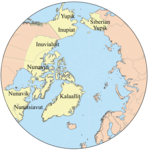
Scandinavia is a subregion of Northern Europe, with strong historical, cultural, and linguistic ties between its constituent peoples. Scandinavia most commonly refers to Denmark, Norway, and Sweden. It can sometimes also refer to the Scandinavian Peninsula. In English usage, Scandinavia is sometimes used as a synonym for Nordic countries. Iceland and the Faroe Islands are sometimes included in Scandinavia for their ethnolinguistic relations with Sweden, Norway and Denmark. While Finland differs from other Nordic countries in this respect, some authors call it Scandinavian due to its economic and cultural similarities.

The demography of Sweden is monitored by the Statistiska centralbyrån. Sweden's population was 10,555,448, making it the 15th-most populous country in Europe after Czech Republic, the 10th-most populous member state of the European Union, and the 87th-most populous country in the world. The total fertility rate was rated at 1.66 in 2020, which is far below the replacement rate of 2.1.
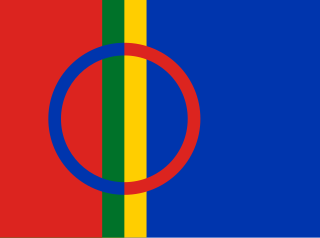
The Sámi are the traditionally Sámi-speaking peoples inhabiting the region of Sápmi, which today encompasses large northern parts of Norway, Sweden, Finland, and of the Kola Peninsula in Russia. The region of Sápmi was formerly known as Lapland, and the Sámi have historically been known in English as Lapps or Laplanders, but these terms are regarded as offensive by the Sámi, who prefer the area's name in their own languages, e.g. Northern Sámi Sápmi. Their traditional languages are the Sámi languages, which are classified as a branch of the Uralic language family.

The Nordic Council is the official body for formal inter-parliamentary Nordic cooperation among the Nordic countries. Formed in 1952, it has 87 representatives from Denmark, Finland, Iceland, Norway, and Sweden as well as from the autonomous areas of the Faroe Islands, Greenland, and Åland. The representatives are members of parliament in their respective countries or areas and are elected by those parliaments. The Council holds ordinary sessions each year in October/November and usually one extra session per year with a specific theme. The council's official languages are Danish, Finnish, Icelandic, Norwegian, and Swedish, though it uses only the mutually intelligible Scandinavian languages—Danish, Norwegian, and Swedish—as its working languages. These three comprise the first language of around 80% of the region's population and are learned as a second or foreign language by the remaining 20%.

Demographic features of the population of Norway, including Jan Mayen, and Svalbard, where the hospital is not equipped for births, include population density, ethnicity, education level, health of the populace, economic status, religious affiliations and other aspects.
Nordic folk music includes a number of traditions of Nordic countries, especially Scandinavian. The Nordic countries are Iceland, Norway, Sweden, Denmark and Finland.
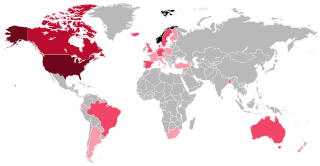
Norwegians are an ethnic group and nation native to Norway, where they form the vast majority of the population. They share a common culture and speak the Norwegian language. Norwegians are descended from the Norse of the Early Middle Ages who formed a unified Kingdom of Norway in the 9th century. During the Viking Age, Norwegians and other Norse peoples conquered, settled and ruled parts of the British Isles, the Faroe Islands, Iceland and Greenland. Norwegians are closely related to other descendants of the Norsemen such as Danes, Swedes, Icelanders and the Faroe Islanders, as well as groups such as the Scots whose nation they significantly settled and left a lasting impact in, particularly the Northern Isles.

Icelanders are an ethnic group and nation who are native to the island country of Iceland. They speak Icelandic, a North Germanic language.
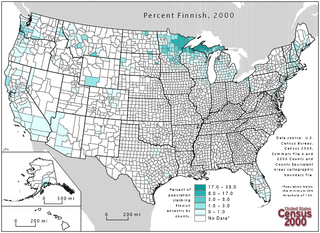
Finnish Americans comprise Americans with ancestral roots in Finland, or Finnish people who immigrated to and reside in the United States. The Finnish-American population is around 650,000. Many Finnish people historically immigrated to the Upper Peninsula of Michigan and the Iron Range of northern Minnesota to work in the mining industry; much of the population in these regions is of Finnish descent.

Scandinavism, also called Scandinavianism or pan-Scandinavianism, is an ideology that supports various degrees of cooperation among the Scandinavian countries. Scandinavism comprises the literary, linguistic and cultural movement that focuses on promoting a shared Scandinavian past, a shared cultural heritage, a common Scandinavian mythology and a common language or dialect continuum and which led to the formation of joint periodicals and societies in support of Scandinavian literature and languages. The movement was most popular among Danes and Swedes. Nordism expands the scope to include Iceland and Finland.

Swedish Americans are Americans of Swedish descent. The history of Swedish Americans dates back to the early colonial times, with notable migration waves occurring in the 19th and early 20th centuries and approximately 1.2 million arriving between 1865–1915. These immigrants settled predominantly in the Midwest, particularly in states like Minnesota, Illinois, and Wisconsin, in similarity with other Nordic and Scandinavian Americans. Populations also grew in the Pacific Northwest in the states of Oregon and Washington at the turn of the twentieth century.
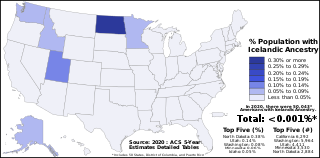
Icelandic Americans are Americans of Icelandic descent or Iceland-born people who reside in the United States. Icelandic immigrants came to the United States primarily in the period 1873–1905 and after World War II. There are more than 40,000 Icelandic Americans according to the 2000 U.S. census, and most live in the Upper Midwest. The United States is home to the second largest Icelandic diaspora community in the world after Canada.

The demographics of Minnesota are tracked by the United States Census Bureau, with additional data gathered by the Minnesota State Demographic Center. According to the most recent estimates, Minnesota's population as of 2020 was approximately 5.7 million, making it the 22nd most populous state in the United States. The total fertility rate in Minnesota was roughly 1.87 in 2019, slightly below the replacement rate of 2.1.
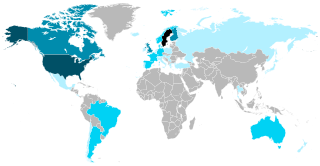
The Swedish diaspora consists of emigrants and their descendants, especially those that maintain some of the customs of their Swedish culture. Notable Swedish communities exist in the United States, Argentina, Australia, Canada, New Zealand, Brazil, and the United Kingdom as well as others.
Nordic Brazilians refers to Brazilians of full or partial Nordic ancestry, or Nordic-born people residing in Brazil.
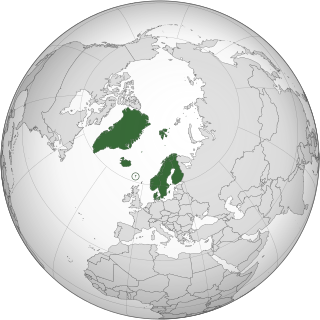
The Nordic countries are a geographical and cultural region in Northern Europe and the North Atlantic. It includes the sovereign states of Denmark, Finland, Iceland, Norway and Sweden; the autonomous territories of the Faroe Islands and Greenland; and the autonomous region of Åland.

The Norwegian diaspora consists of Norwegian emigrants and their descendants, especially those that became Norwegian Americans. Emigrants also became Norwegian Canadians, Norwegian Australians, Norwegian New Zealanders, Norwegian Brazilians, Kola Norwegians and Norwegian South Africans.
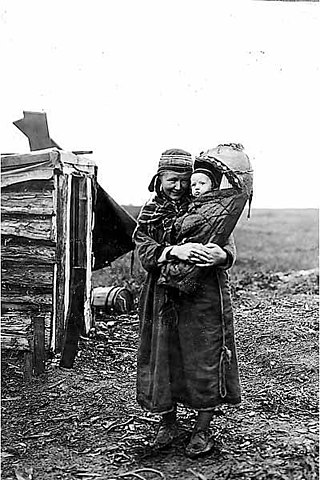
Sámi Americans are Americans of Sámi descent, who originate from Sápmi, the northern regions of Norway, Sweden, Finland, and the Kola Peninsula of Russia. The term Lapp Americans has been historically used, though lapp is considered derogatory by the Sámi.
Nordic Australians are Australian citizens whose origins are found in any of the Nordic countries, or people from any of these countries who live in Australia. Danish immigrants made up the largest group by far.

Nordic immigration to North America encompasses the movement of people from the Nordic countries of Sweden, Denmark, Norway, Iceland, and Finland to the North America, mainly the United States and Canada, from the 17th to the 20th centuries. These immigrants were drawn to the New World by factors ranging from economic opportunities to religious freedom and challenges in their native lands. Their legacy has significantly shaped the cultural, social, and economic landscape of the Americas.




















